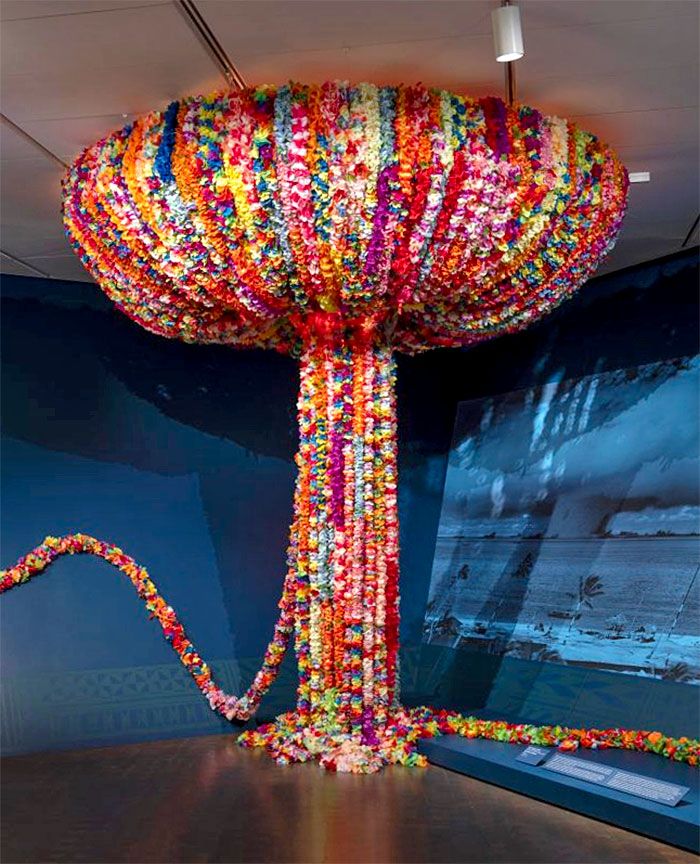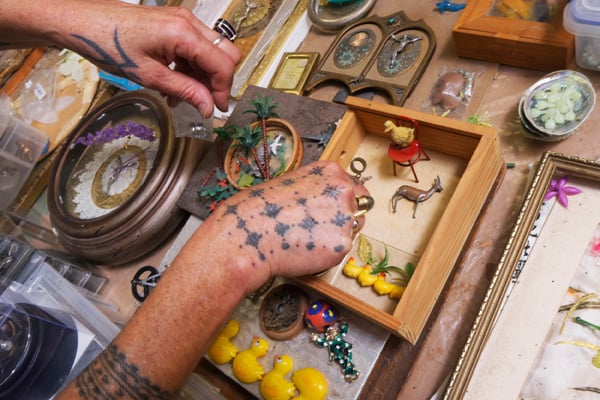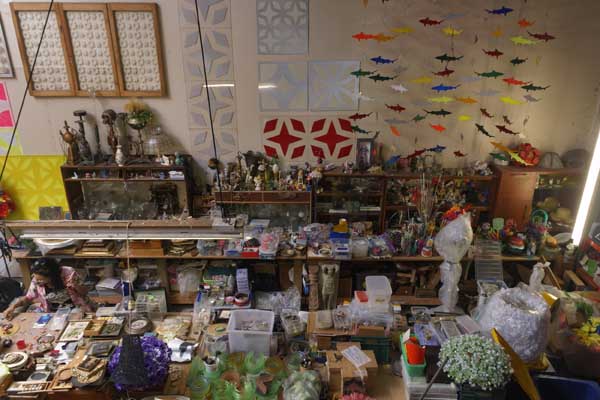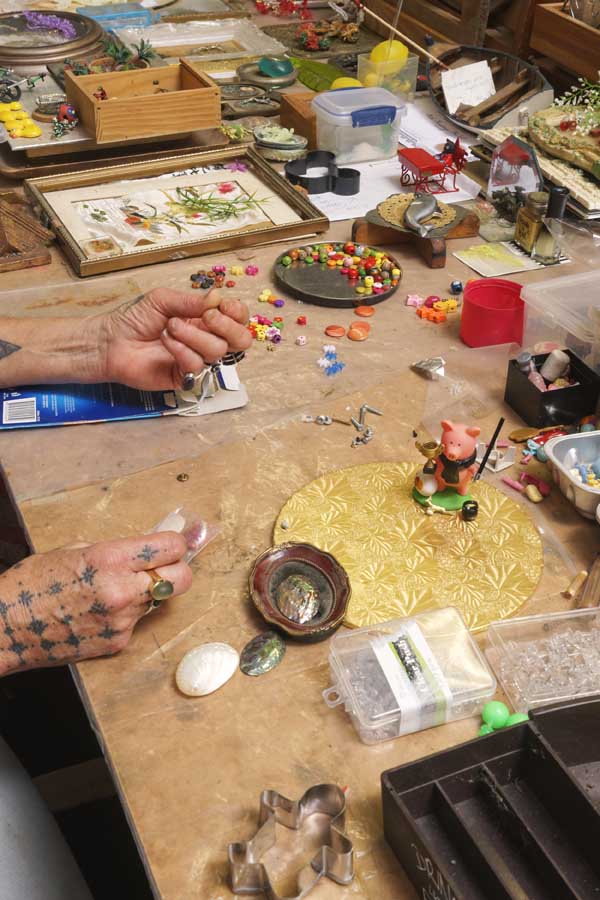New Zealand artist Niki Hastings-McFall (b. 1959) started her career as a jeweler, fabricating adornments that drew from her Samoan and Pākehā heritage. Over the decades, the artist’s creations have evolved in more sculptural dimensions and she has become well-known for her “lei bombing” installations, in which hundreds of nylon floral lei are strung together to form sweeping installations that play with ideas of organic and kitsch as well as questions of the Western gaze. Today, Hastings-McFall is regarded as one of the leading contemporary artists who is credited with bringing Pasifika culture to the international stage.
Currently, the Denver Art Museum is showcasing “Islands Beyond Blue: Niki Hastings-McFall and Treasures from the Oceania Collection,” a monumental site-specific installation by the artist that responds to 25 treasures of Oceanic art from the museum’s collection.
Coinciding with the installation, we spoke with the artist about her studio life, the music that inspires her, and living in the ‘Wild West’ of New Zealand.

Installation view “Islands Beyond Blue” 2023. Courtesy of the Denver Art Museum.
Tell us about your studio. Where is it, how did you find it, what kind of space is it, etc.?
I’d begun working in what could be described as a small cupboard under my house but the scale of work I’d begun making dictated larger premises. Iconic New Zealand stonemason John Edgar, jeweler Jason Hall, and blacksmith Jon Hall had a two-year lease on a ramshackle old, corrugated iron boat shed down on the Whau estuary. I was working on a large commission for an exhibition in Kaoshiung and they kindly let me work there. It was boiling hot in summer with the sun baking us under the uninsulated tin and only a couple of doors to let any air through or freezing cold in winter with wind whistling through what looked like multiple bullet holes and a chronically leaky roof plus a cantankerous drunken old nutbar for a landlord. We loved it. However, when the lease came up for renewal, the three of us decided to go for broke and invest in our own separate studios, rather than pay someone else’s mortgage. Trading in the suburban house and the lawnmower for a warehouse with a 1-bedroom apartment on the banks of the Oratia Stream in West Auckland, where I was born and bred was the logical next step. It was pretty feral back then in this small enclave of industrial factories and warehouses out in the wild west and when you gained entry into another neighbor’s cavernous space there were some mind-blowing collections of objects, ingenious, quirky interior design and real characters with intriguing stories hidden away behind the drably uniform industrial facade.
What made you choose this particular studio over others?
The main wall is north-facing, ensuring all-day sun, or at least light streaming through the windows. It also has a reasonably large car park, dedicated to this unit alone, which was immediately fitted out with a gang headquarters 7-foot-high fence topped by barbed wire. (To keep the dog contained.) A large shipping container was installed down one end, which became the lapidary workshop for several years. It is now the main housing for an American Staffordshire terrier, seven rescued Australian magpies, and two Eclectus parrots. The whole place has been the home or hospital or final resting place for many different bird species over the years. Injured, sick or nestling birds have been rescued by members of the public and subsequently delivered here. They are diagnosed, treated, and most are rehabbed, released or rehomed. The car park has become a garden and a small zoo over time, which is very unusual and quite unique in the urban Warehouse World with its asphalt, concrete, tilt-up slab walls, and onerous body corp regimes, even out here in untamed wild west. Luck was shining down that day and I feel extremely fortunate to have got the best of both worlds.

Courtesy of Niki Hastings-McFall.
Do you have studio assistants or other team members working with you? What do they do?
I used to have an endless supply of eager, helpful, and inspiring students. I was working part-time at the University of Auckland’s Manukau School of Visual Arts as a technician and a lecturer in the Jewelry and Sculpture department. Part of the curriculum’s professional practice module required time in an artist’s studio. I always maintain I learned more from my students than vice versa, which was simultaneously exhilarating, inspiring, and very humbling. Anyone who has suffered the excruciating experience of trying to deal digitally with me in cyberspace will laugh when I say that a large portion of their studio time was spent on untangling the disastrous result after I’ve been unleashed on the PC for a few days on my own. I swear it’s genetically encoded in their DNA whereas I am a plodding, clumsy, digitally challenged Cybersaurus Vex of Luddite proportions.
How many hours do you typically spend in the studio, what time of day do you feel most productive, and what activities fill the majority of that time?
I spend the majority of my day divided between looking after my “zoo-ette” as well as any feathered patients currently resident, and working. I’m useless in the morning and always have been, so I research or make calls or get supplies but I start revving up around midday. Afternoons are frenetic, frantic, and frenzied culminating in bird o’clock around 4 or 5 p.m. Cooking, feeding, cleaning, medicating, nursing, changing dressings, bedding, bathing, and other mindless domestic trivia take place and finally when everyone is settled and the whole world is quiet I’ll often work till 2 or 3 a.m.
What is the first thing you do when you walk into your studio (after turning on the lights)?
Wander about aimlessly in a mouth-breathing daze, looking lobotomized, I imagine. It’s a kind of dazed ritual trance that grounds me in the space as I slowly gather together the tools, materials, and focus required for that day’s work.

Courtesy of Niki Hastings-McFall.
What is a studio task on your agenda this week that you are most looking forward to?
It’s not been the most brilliant week so that’s hard to answer. Probably actually making something instead of resentfully and viciously bashing my keyboard.
What are you working on right now? Please send us a few smartphone shots of a work in progress—or photos of different works in various states of completion—in a way that you think will provide insight into your process.
My work transitioned from a small jewelry scale to a larger domestic scale and then further in response to internal/ external architectural requirements. It was a tricky transition, and I was on a steep learning curve. With many mishaps along the way.
At present, I am working on the “Islands Beyond Blue” opening at Denver Art Museum. The project has been in gestation for about nine months, and I have only accolades, adulation, and absolute admiration for the entire team. They are superbly efficient, very focused, smart, insightful, and extremely professional superheroes. Wonderful to work with in every way and great fun too. The best bunch I have ever encountered in all my time and travels.
Once this project is completed, I have a couple of public commissions to wind up and will continue working toward a solo exhibition. I’ve been fabricating a series of small works that have been in the pipeline for three or four years. It’s such a novel situation to have the luxury of time to consider every detail and cull unmercifully. I’m constructing objects on a finely detailed, more jewel-like, miniature scale this time depicting various random scenarios. Slices of time held fast in the moment, like fossils in amber, contained, preserved, considered, and contemplated well beyond their individual allotted lifespans or wildest imaginations.
What tool or art supply do you enjoy working with the most, and why? Please send us a snap of it.
If I’m making other works, my favorite materials at the moment are tiny quirky random objects I’ve sourced from stuff people chuck out, usually brightly colored and shiny. I like to gather mundane discarded detritus and excise the cataracts of perception dulled by familiarity. To present an alternative appreciation of the unnoticed and unseen and entertain the possibility of wonder and beauty in the everyday.
What kind of atmosphere do you prefer when you work? Is there anything you like to listen to/watch/read/look at etc. while in the studio for inspiration or as ambient culture?
I listen to a variety of music very, very loudly. Dusty Springfield, L7, JS Bach, the Rubettes, Rage Against the Machine, Frazey Ford, Motorhead, Cissy Houston, the Stones, Elle King, David Bowie, System of a Down, Lou Reed, the Pretty Reckless, Stevie Ray Vaughan, the Byrds, Skrillex, George Benson, AC/DC, Lizzo, Captain Hook, Pachelbel, the Supremes, Smashing Pumpkins, Caro Emerald, Jimmy Cliff, Steely Dan, Burt Bacharach, Neil Young, Chopin, Grace Jones, Stevie Wonder, Pink Floyd, Shepherds Reign, Clapton, Alison Krauss, etc.

Courtesy of Niki Hastings-McFall.
How do you know when an artwork you are working on is clicking? How do you know when an artwork you are working on is a dud?
It’s clicking when you get that rush and you’re sitting behind your eyes, looking out. Something is making a small squealing sound and it’s you. And you just know. It’s a dud when you keep trying to convince yourself it’s okay. Methinks the lady doth protest too much etc. Let it go, Pig. Let it go.
What’s the last museum exhibition or gallery show you saw that really affected you and why?
Robin White at Auckland Art Gallery Toi o Tāmaki. It was wonderful to see so many well-known works together and in the flesh. And incredibly inspiring to see the relatively new works based on tapa cloth. Just stunning, and what a progression. An artist that keeps growing and evolving and producing work that to me, eclipsed her past work and I didn’t think that could be possible. So exciting and inspiring and utterly cleverly beautiful
Is there anything in your studio that a visitor might find surprising?
An empty space. A glimpse of the floor. (They’re very seldom seen in my space.) A very industrious black-and-white Australian magpie “helping” me with my work. A mummified hare’s head. A 1989 Ducati 750 Sport.
What’s the last thing you do before you leave the studio at the end of the day (besides turning off the lights)?
Tidy up. Set out the most successful piece or inspiring material I’ve worked with that day so it’s one of the first things I see the next day.
What do you like to do right after that?
Eat. Drink. Watch something mindless on TV. Eat more. Let sleep knit up the raveled sleeve of care.










